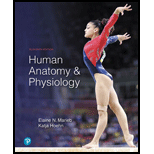
To analyze:
The following atoms 6C12, 6C13, and 6C14, and:
1. State the similarity in all of them.
2. The difference between them.
3. The definition for these groups of elements.
4. The atomic configuration of 6C12 showing relative positions and numbers of the subatomic particle by using the planetary model.
Introduction:
Atom is the smallest unit of any particle. When two elements combine with each other, the formation of molecules occurs. Molecules combine to form a molecular compound. An element is designated with the atomic number and atomic mass. An atomic number of an element is the number of protons of the element. Atomic mass can be defined as the summation of thenumber of protons as well as the neutrons present in the nucleus of the atom of the element.
Want to see the full answer?
Check out a sample textbook solution
Chapter 2 Solutions
Human Anatomy & Physiology (11th Edition)
- What three things did the bohr model add to our understanding of atomic structure?arrow_forwardElemental analysis of a compound with molar mass 342.3 g/mol gives the following mass percent composition: C 42.11%, H 6.48%, O 51.41%. Find the molecular formula of the compound. Enter your answer in the space below using the following format: if the molecular formula of a compound containing elements X, Y, and Z is X2YZ3 enter your answer as X2YZ3.arrow_forwardA principal shell with a value of n=3 would contain s,p,d, and f orbitals true or falsearrow_forward
- which of the sub-atomic particles is commonly represented by this symbol:"e-"?arrow_forwardWhich electron shell is the valence shell of an atom, and what is its significance?arrow_forwardChlorine is an element with the symbol Cl. Draw and label atomic structure of chlorine indicating the number and locations of protons, neutrons and electrons in one atom of chlorine.arrow_forward
- A compound with empirical formula C2H5O was found in a separate experiment to have a molar mass of approximately 90 g. What is the molecular formula of the compound?arrow_forwardWhich of the following levels in the shell model of an atom can hold up to two electrons? A. The second shell B. The first shell C. The third shellarrow_forwardwhat subatomic particle is present in the nucleus of an atom?arrow_forward
- Define the atomic mass of an atom. What are two things that make up an atom?arrow_forwardExplain why lung and soft tissue appear different on a radiograph when they have both an effective atomic number of 7.4?arrow_forwardWhy do the 3s, 3p, and 3d orbitals have the same energy in a hydrogen atom but different energies in a many- electron atom?arrow_forward
 Principles Of Radiographic Imaging: An Art And A ...Health & NutritionISBN:9781337711067Author:Richard R. Carlton, Arlene M. Adler, Vesna BalacPublisher:Cengage Learning
Principles Of Radiographic Imaging: An Art And A ...Health & NutritionISBN:9781337711067Author:Richard R. Carlton, Arlene M. Adler, Vesna BalacPublisher:Cengage Learning

